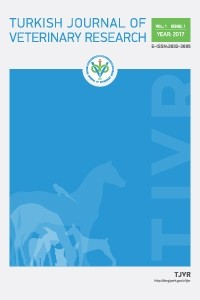
Turkish Journal of Veterinary Research
Yazarlar: ["Vural DENİZHAN", "Ayşe KARAKUŞ"]
Konular:-
DOI:10.47748/tjvr.1149395
Anahtar Kelimeler:Gastrointestinal parazit,At,Van
Özet: Objective: This study was carried out to determine the distribution of digestive system parasites in horses in İpekyolu, Tusba, Özalp, Saray and Gürpınar districts in Van between June 2019 and May 2020. Materials and Methods: Materials of this study consist of a total of 95 horse stool samples, 58 male and 37 female, from different races, ranging in age from 1 to 12 years. Results: Various parasitic infections were detected in 65 (68.42%) of 95 horses examined by stool examination. While 55 of 65 infected horse stool samples were infected with a single species, it was determined that stool samples of 10 horses were infected with two species. In infected horses, at most Strongylidae spp. (44.21%) were detected followed by Parascaris equorum (11.57%), Eimeria leuckarti (6.31%), Anoplocephala spp. (5.26%), Oxyuris equi (4.21%), D. dendriticum (3.16%), and Fasciola spp. (4.21%). When the infected horses were evaluated according to age groups, parasitic infections were detected in 34 (35.79%) horses aged 8 years and above, 29 (30.53%) between the ages of 5-7 and 12 (12.63%) between the ages of 1-4. When the infected horses were evaluated according to gender groups, parasitic infections were found in 38 (65.51%) of 58 male horses and 27 (72.92%) of 37 female horses. Conclusion: As a result, in this study, it was determined that the horses in the Van region were infected with various parasite species. In the study, helminth infections were found more frequently, and it was predicted that it should be combated with anthelmentics, taking into account the development of resistance against these parasites.